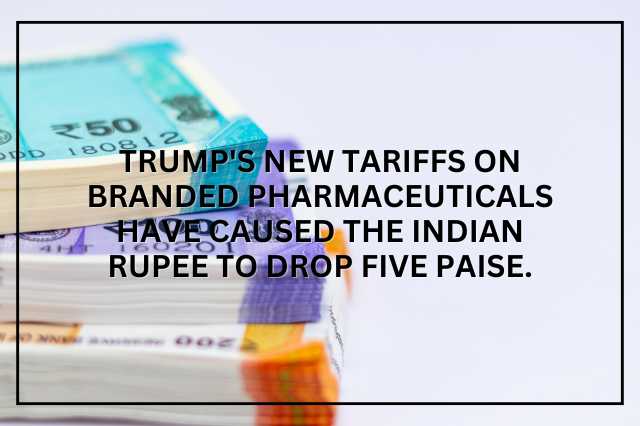
loading...

Trump's new tariffs on branded pharmaceuticals have caused the Indian rupee to drop five paise.
On September 26, US President Donald Trump imposed new duties on the import of branded or patented pharmaceutical products, which caused the Indian rupee to open flat and drop by 5 paise. After opening at 88.6875 against the US dollar, the local currency quickly declined to 88.72 against the US dollar, down from 88.6725 at the previous close. Foreign investors have already sold $1.3 billion worth of stocks this month, putting pressure on the rupee, which has down 0.5 percent so far in September. According to Bloomberg data, Asian currencies are also declining in value relative to the US dollar. The Taiwanese dollar is down 0.42 percent, the Thai baht is down 0.26 percent, the Malaysian ringgit is down 0.21 percent, and the South Korean won is down 0.12 percent. It's still unclear how branded or patented pharmaceutical products would be classified when it comes to Asia specifically, but our working assumption is that generic medications and pharmaceuticals delivered to the US from countries like India won't be included. As a result, India might be exempt from these pronouncements for the time being, according to a report from Mitsubishi UFJ Financial Group (MUFG), a financial organization located in Japan. The USD/INR is testing important levels, with support at 88.40 and resistance between 89.00 and 89.20, according to Amit Pabari, managing director of CR Forex Advisors. "It seems that tariffs and increases in visa fees are driving the upward trend more so than the general strength of the currency. The first indication of a possible trend reversal would be a closure below 88.20, but a recovery in the rupee may be supported by trade discussions progressing or a weaker dollar index. The Indian rupee weakened by five paise to settle at 88.72 against the US dollar on September 26, following the announcement of new tariffs by US President Donald Trump on branded and patented pharmaceutical imports. The local currency, which opened flat at 88.6875, quickly slipped under pressure from the policy move and consistent foreign investor outflows. So far in September, overseas investors have pulled $1.3 billion out of Indian equities, contributing to a 0.5% depreciation of the rupee this month. The fall in the rupee also mirrors the trend across Asian currencies, which have been struggling against the strengthening US dollar. The Taiwanese dollar, Thai baht, Malaysian ringgit, and South Korean won all recorded declines, reflecting broader regional weakness. Analysts point out that while Trump’s tariff move added immediate pressure, the general dollar strength is also playing a key role in keeping emerging market currencies subdued. Financial analysts at Mitsubishi UFJ Financial Group (MUFG) indicated that generic drugs from India are unlikely to be impacted by these tariff measures. This suggests that while the direct effect on Indian pharmaceutical exporters may be limited, the uncertainty around classification of pharmaceutical products could keep investor sentiment cautious in the short term. Experts tracking currency markets highlight that the rupee is testing important technical levels, with support placed at 88.40 and resistance between 89.00 and 89.20. According to CR Forex Advisors, tariff announcements and visa fee hikes have had a stronger influence on the rupee’s movement than dollar strength alone. Any recovery in the rupee, they suggest, will depend on progress in Indo-US trade talks or a weakening of the dollar index in the weeks ahead.
Just Login and Customize
Our Features Easily.
USERNAME : [email protected]
PASSWORD : admin1234